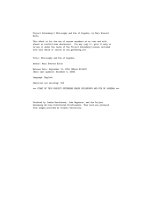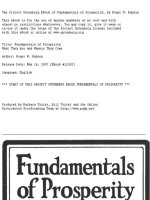Project Gutenberg''''s Ethel Morton''''s Enterprise, by Mabell S.C. Smith pot
Bạn đang xem bản rút gọn của tài liệu. Xem và tải ngay bản đầy đủ của tài liệu tại đây (2.36 MB, 588 trang )
Project Gutenberg's Ethel Morton's
Enterprise, by Mabell S.C. Smith
This eBook is for the use of anyone
anywhere at no cost and with
almost no restrictions whatsoever. You may
copy it, give it away or
re-use it under the terms of the Project
Gutenberg License included
with this eBook or online at
www.gutenberg.net
Title: Ethel Morton's Enterprise
Author: Mabell S.C. Smith
Release Date: March 22, 2004 [EBook
#11660]
Language: English
*** START OF THIS PROJECT GUTENBERG EBOOK
ETHEL MORTON'S ENTERPRISE ***
Produced by Kevin Handy, Dave Maddock,
Garrett Alley, and the Online
Distributed Proofreading Team.
ETHEL
MORTON'S
ENTERPRISE
By
MABELL S.C. SMITH
CONTENTS
I. HOW IT STARTED
II. A SNOW MAN AND SEED
CATALOGUES
III. DOROTHY TELLS HER
SECRET
IV. GARDENING ON PAPER
V. A DEFECT IN THE TITLE
VI. WILD FLOWERS FOR
HELEN'S GARDEN
VII. COLOR SCHEMES
VIII. CAVE LIFE
IX. "NOTHING BUT LEAVES"
X. THE U.S.C. AND THE
COMMUNITY
XI. THE FLOWER FESTIVAL
XII. ENOUGH TO GIVE AWAY
XIII. IN BUSINESS
XIV. UNCLE DAN'S
RESEARCHES
XV. FUR AND FOSSILS
XVI. FAIRYLAND
XVII. THE MISSING HEIRESS
CHAPTER I
HOW IT STARTED
Ethel Morton, called from the color of her
eyes Ethel "Blue" to distinguish her from
her cousin, also Ethel Morton, whose
brown eyes gave her the nickname of
Ethel "Brown," was looking out of the
window at the big, damp flakes of snow
that whirled down as if in a hurry to cover
the dull January earth with a gay white
carpet.
"The giants are surely having a pillow
fight this afternoon," she laughed.
"In honor of your birthday," returned her
cousin.
"The snowflakes are really as large as
feathers," added Dorothy Smith, another
cousin, who had come over to spend the
afternoon.
All three cousins had birthdays in January.
The Mortons always celebrated the
birthdays of every member of the family,
but since there were three in the same
month they usually had one large party and
noticed the other days with less ceremony.
This year Mrs. Emerson, Ethel Brown's
grandmother, had invited the whole United
Service Club, to which the girls belonged,
to go to New York on a day's expedition.
They had ascended the Woolworth Tower,
gone through the Natural History Museum,
seen the historic Jumel Mansion, lunched
at a large hotel and gone to the
Hippodrome. Everybody called it a
perfectly splendid party, and Ethel Blue
and Dorothy were quite willing to
consider it as a part of their own birthday
observances.
Next year it would be Dorothy's turn. This
year her party had consisted merely in
taking her cousins on an automobile ride.
A similar ride had been planned for Ethel
Blue's birthday, but the giants had plans of
their own and the young people had had to
give way to them. Dorothy had come over
to spend the afternoon and dine with her
cousins, however. She lived just around
the corner, so her mother was willing to
let her go in spite of the gathering drifts,
because Roger, Ethel Brown's older
brother, would be able to take her home
such a short distance, even if he had to
shovel a path all the way.
The snow was so beautiful that they had
not wanted to do anything all the afternoon
but gaze at it. Dicky, Ethel Brown's little
brother, who was the "honorary member"
of the U.S.C., had come in wanting to be
amused, and they had opened the window
for an inch and brought in a few of the
huge flakes which grew into ferns and
starry crystals under the magnifying glass
that Mrs. Morton always kept on the desk.
"Wouldn't it be fun if our eyeth could thee
thingth like that!" exclaimed Dicky, and
the girls agreed with him that it would add
many marvels to our already marvellous
world.
"As long as our eyes can't see the wee
things I'm glad Aunt Marion taught us to
use this glass when we were little," said
Ethel Blue who had been brought up with
her cousins ever since she was a baby.
"Mother says that when she and Uncle
Roger and Uncle Richard," said Dorothy,
referring to Ethel Brown's and Ethel
Blue's fathers, her uncles—"were all
young at home together Grandfather
Morton used to make them examine some
new thing every day and tell him about it.
Sometimes it would be the materials a
piece of clothing was made of, or the
paper of a magazine or a flower—
anything that came along."
"When I grow up," said Ethel Blue, "I'm
going to have a large microscope like the
one they have in the biology class in the
high school. Helen took me to the class
with her one day and the teacher let me
look through it. It was perfectly
wonderful. There was a slice of the stem
of a small plant there and it looked just as
if it were a house with a lot of rooms.
Each room was a cell, Helen said."
"A very suitable name," commented Ethel
Brown.
"What are you people talking about?"
asked Helen, who came in at that instant.
"I was telling the girls about that time
when I looked through the high school
microscope," answered Ethel Blue.
"You saw among other things, some cells
in the very lowest form of life. A single
cell is all there is to the lowest animal or
vegetable."
"What do you mean by a single cell?"
"Just a tiny mass of jelly-like stuff that is
called protoplasm. The cells grow larger
and divide until there are a lot of them.
That's the way plants and animals grow."
"If each is as small as those I saw under
the microscope there must be billions in
me!" and Ethel Blue stretched her arms to
their widest extent and threw her head
upwards as far as her neck would allow.
"I guess there are, young woman," and
Helen went off to hang her snowy coat
where it would dry before she put it in the
closet.
"There'th a thnow flake that lookth like a
plant!" cried Dicky who had slipped open
the window wide enough to capture an
especially large feather.
"It really does!" exclaimed Ethel Blue,
who was nearest to her little cousin and
caught a glimpse of the picture through the
glass before the snow melted.
"Did it have 'root, stem and leaves'?"
asked Dorothy. "That's what I always was
taught made a plant—root, stem and
leaves. Would Helen call a cell that you
couldn't see a plant?"
"Yes," came a faint answer from the hall.
"If it's living and isn't an animal it's a
vegetable—though way down in the lower
forms it's next to impossible to tell one
from the other. There isn't any rule that
doesn't have an exception."
"I should think the biggest difference
would be that animals eat plants and
plants eat—what do plants eat?" ended
Dorothy lamely.
"That is the biggest difference," assented
Helen. "Plants are fed by water and
mineral substances that come from the soil
directly, while animals get the mineral
stuff by way of the plants."
"Father told us once about some plants
that caught insects. They eat animals."
"And there are animals that eat both
vegetables and animals, you and I, for
instance. So you can't draw any sharp
lines."
"When a plant gets out of the cell stage
and has a 'root, stem and leaves' then you
know it's a plant if you don't before,"
insisted Dorothy, determined to make her
knowledge useful.
"Did any of you notice the bean I've been
sprouting in my room?" asked Helen.
"I'll get it, I'll get it!" shouted Dicky.
"Trust Dicky not to let anything escape his
notice!" laughed his big sister.
very carefully a shallow earthenware dish
from which some thick yellow-green tips
were sprouting.
"I soaked some peas and beans last
week," explained Helen, "and when they
were tender I planted them. You see
they're poking up their heads now."
"They don't look like real leaves,"
commented Ethel Blue.
"This first pair is really the two halves of
the bean. They hold the food for the little
plant. They're so fat and pudgy that they
never do look like real leaves. In other
plants where there isn't so much food they
become quite like their later brothers."
"Isn't it queer that whatever makes the
plant grow knows enough to send the
leaves up and the roots down," said
Dorothy thoughtfully.
"That's the way the life principle works,"
agreed Helen. "This other little plant is a
pea and I want you to see if you notice any
difference between it and the bean."
She pulled up the wee growth very
delicately and they all bent over it as it lay
in her hand.
"It hathn't got fat leaveth," cried Dicky.
has beaten you girls. You see the food in
the pea is packed so tight that the pea gets
discouraged about trying to send up those
first leaves and gives it up as a bad job.
They stay underground and do their
feeding from there."
"A sort of cold storage arrangement,"
smiled Ethel Brown.
"After these peas are a little taller you'd
find if you pulled them up that the supply
of food had all been used up. There will
be nothing down there but a husk."
"What happens when this bean plant uses
up all its food?"
"There's nothing left but a sort of skin that
drops off. You can see how it works with
the bean because that is done above the
ground."
"Won't it hurt those plants to pull them up
this way?"
"It will set them back, but I planted a good
many so as to be able to pull them up at
different ages and see how they looked."
"You pulled that out so gently I don't
believe it will be hurt much."
"Probably it will take a day or two for it
to catch up with its neighbors. It will have
to settle its roots again, you see."
"What are you doing this planting for?"
asked Dorothy.
"For the class at school. We get all the
different kinds of seeds we can—the ones
that are large enough to examine easily
with only a magnifying glass like this one.
Some we cut open and examine carefully
inside to see how the new leaves are to be
fed, and then we plant others and watch
them grow."
"I'd like to know why you never told me
about that before?" demanded Ethel
Brown. "I'm going to get all the grains and
fruits I can right off and plant them. Is all
that stuff in a horse chestnut leaf-food?"
"The horse chestnut is a hungry one, isn't
it?"
"I made some bulbs blossom by putting
them in a tall glass in a dark place and









